Growing cucumbers in a greenhouse
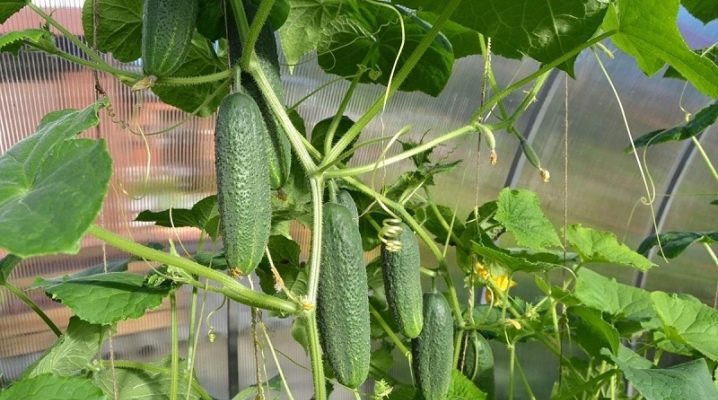
Growing cucumbers in a greenhouse is not a very common practice, but it is not exclusive either. And at the same time, the advice of an agronomist (or just an experienced summer resident) will not be superfluous. Because there are many important points in this matter: from the timing of disembarkation to the prevention of diseases.
Timing
Seedlings are ready to be planted in greenhouse conditions when they are 25-30 days old. That is taking into account these data, you can count 30 days of growth and 5 days for stably sprouted shoots, and so it will turn out to find the optimal date for sowing seed. And this is true for any region, whatever the weather conditions there may be. At the same time, you need to monitor the temperature indicators.
For example, in the Central region, in mid-May, it is already possible to plant cucumbers in a greenhouse. Only before that you need to determine the temperature of the soil in it, it must be at least +15 degrees. And in order to measure the degree of the soil, the measurement site must first be covered with a board (otherwise the indicators may be false if the sun warms up the earth too much). And the measurement is carried out in the morning, at which time it is most objective. You need to dig in a thermometer into the garden no more than 20 cm.
And if you want to warm up the soil faster, black plastic wrap will help. Sometimes biofuel is also used, which is simply dripped into the ground, then poured with boiling water, and the top is also covered.
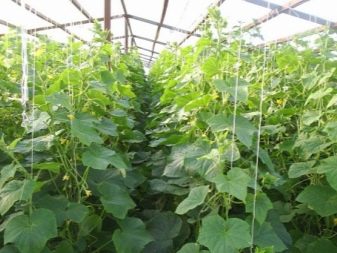

The necessary conditions
A rich harvest can only be expected from those cucumbers that grow on soils with good organic composition. Since the roots of the plant are weak and will not germinate deeper than 20 cm, the culture is very sensitive to soil fertility. And, as experienced summer residents say, the cucumber will be empty without manure. Therefore, you definitely do not need to be afraid of high doses of organic matter, which cucumbers love so much. One square meter can contain from 4 to 20 kg of organic matter. You can fertilize the soil with manure or leaves, peat, rotted debris, sawdust, straw. And necessarily with nitrogen added to the compost. And it is better to apply fertilizers locally: dig a groove along the bed, and lay out a 15 cm layer of top dressing, and then cover it tightly with earth.
With regard to the microclimate in the greenhouse, the recommendations will be as follows:
- regular watering, but without the risk of waterlogging the beds - it is better to warm the water in the sun or take it from those containers that are filled in the greenhouse itself;
- loosening the soil, also regular, is a prerequisite for the normal growth of cucumbers, so it will be easier for air to flow to the roots;
- in order to maintain the desired level of moisture in the beds, it is better to mulch the soil;
- sprinkling is a mandatory measure, and it consists in significantly spraying the green part of the crop with water, after which the liquid will drain slowly to the roots, and so the plant will be saturated with moisture;
- the light regime is 10 hours of light every day, but if this indicator is reduced, cucumbers grow worse (if there is not enough sun, you will have to extend the daylight hours with a phytolamp);
- seedlings are planted when it is +22 in the greenhouse, it will bloom when the degree rises to +25, and bear fruit - from +25 to +30 (growth will stop at +15, and at +7 the culture will die);
- humidity should be high, from 90 to 95%;
- ventilation (but not drafts) is an indispensable condition, which is also the prevention of diseases, for example, rot.
Tomatoes are often neighbors of cucumbers in the greenhouse.But such a neighborhood is far from ideal, because plants require different conditions. With pepper and zucchini - the same story. But you can plant next to cabbage. As with corn, for example.
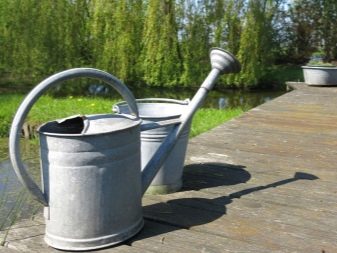
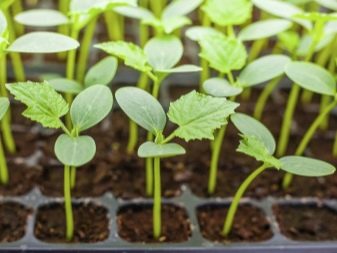
Greenhouse preparation
In loose and sufficiently fertile soil, which perfectly retains moisture and allows air to pass through, cucumbers will be fine. If the soil in the greenhouse is clay or sandy, a good harvest is unlikely. What are the requirements for the land in the greenhouse:
- if melons or pumpkins grew here in the previous season, it is better to change the soil altogether - it is poor, which the cucumber does not tolerate, and even common diseases / pests can affect the harvest;
- it is better to plant cucumbers where onions or carrots, cabbage or potatoes, peppers were previously grown;
- to prepare the beds, in an amicable way, it is necessary in the fall - to remove all plant residues, dig up the soil, add humus (or compost) in a bucket per 1 m2;
- in the fall, you can add superphosphate and dolomite flour to the ground (the first - 2 tablespoons per square meter, the second - 1 tablespoon), and in the spring, 2 weeks before the seedlings are sent to the ground, you can add peat, humus, sawdust to it, and again dig deep;
- a solution of copper sulfate for disinfecting the beds is also a mandatory measure (for 10 liters of water, 1 tablespoon of the drug);
- in the fall, it would be nice to plant green manure in this place, for example, mustard leaves, and before the first severe frosts, dig up the beds along with mustard - over the winter it will calmly decompose for itself, which will not only enrich the soil, but also be disinfected.
It has already been said about the heating of the soil. By the way, straw can also help it warm up. To do this, you need to remove 15 cm of the top layer of the earth, lay straw on all the beds, compost and humus on top, and then the soil layer returns to its original place.
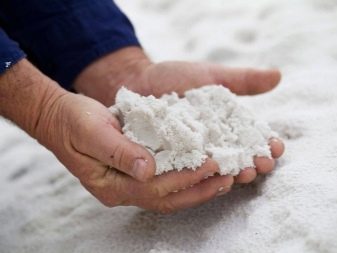
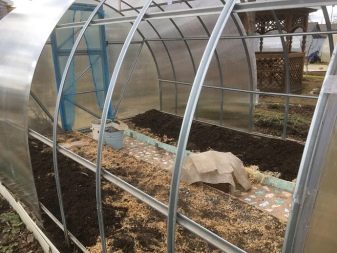
Landing schemes
There are several of them, but the most common one should be described in more detail. It looks like this:
- 2 rows of cucumbers will be placed in the longitudinal bed;
- a distance of 30 cm (or even 40 cm) must be maintained between adjacent bushes;
- seedlings in one bed, but at the same time in adjacent rows, are planted strictly or in parallel, or in a checkerboard pattern (the distance should be at least 50 cm);
- the hole should be strictly under the trellis, or the cucumber net is stretched between the rows.
But this is an option for standard greenhouses, and in fact it can be very wide, for example, 350 cm and wider. And then it is more convenient to place the beds not only near the walls, but also to use the middle space (that is, there will be an additional bed). The main thing is that there will be enough light for the plants. On narrow beds, there are 3 options for planting: in 2 lines, checkerboard seating and one-line.
Planting process
Before planting, the soil in the greenhouse can be moistened with hot water. Then you need to make holes in the ground, and distribute the seedlings in them. Ideally, if it grew in special peat pots. Wherein the deepening is made so that the upper edge of the peat container protrudes above the soil surface. The soil can be tamped down a little. And on top of the ground, where the seedlings have already been planted, a two-centimeter layer with sawdust is sprinkled - it is the root part of the cucumbers that needs to be mulched. You don't need to water the beds for two days.
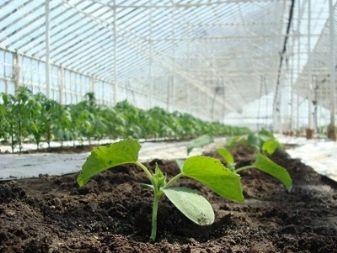
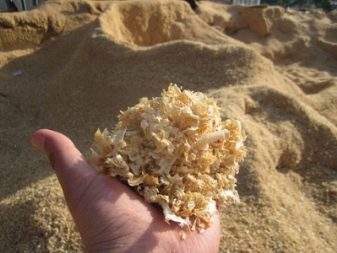
Care
Planting can be said to be the easiest part of growing cucumbers. Even for beginners, it won't be difficult. But then the cultivation begins, which requires systemic care.
Watering
Cucumbers are probably the most responsive crop to watering. Therefore, the irrigation regime must be regular, otherwise high yields can not be expected. Watering should be frequent, especially during dry seasons. Plant leaves should not be allowed to wither. The root system of a cucumber sits very close to the surface of the soil, so it cannot take water from the depths (unlike tomatoes, for example). And the state of the plant will directly depend on watering.
When it is hot and the process of fruit formation has begun, greenhouse cucumbers need daily watering. And sprinkling technology will be a good solution - the water will pour out in a drip manner, evaporate a little. The air humidity in the greenhouse will increase, and this is also important for the plant. In general, 1 sq. m of the garden bed should have 15-25 liters every day or every other day (it depends on the weather). During fruiting, the consumption increases by a third.
Cucumbers are not watered with cold water, this is excluded. This is not due to the fact that they necessarily become bitter. But if you water it cold, the risk of disease will increase significantly.
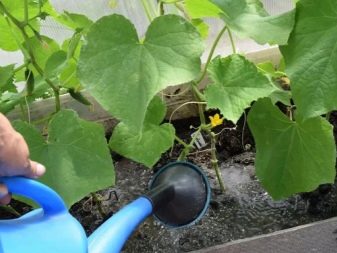
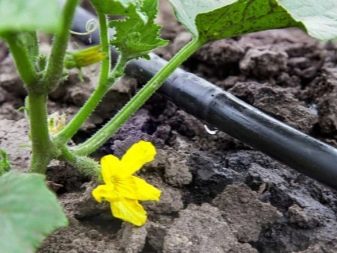
Top dressing
Cucumbers are growing rapidly, and this is the norm. The same new hybrids give the richest yields, but they still need to be “fed”. Therefore, fertilizers are applied once or twice a month, but not from the first days of cultivation. Organic fertilizers are natural compounds: manure, ash, chicken manure, green herbal fertilizer. Seedlings already planted in the ground are not fed with organic matter, but they are fed with ash when they are still preparing a substrate for seeds. But in the greenhouse, you will also need mineral fertilizers. But first, the seedlings ready for planting are fed with nitrogen or complex (but with a large inclusion of nitrogen), because the plant's task at the first stage is precisely to increase the green mass.
After the seedlings are planted in the greenhouse, the soil is not fertilized for 2 weeks. The plant must first take root. Yes, and in the holes when planting, they put enough top dressing for the first time. And then a solution of mullein, ash, and chicken droppings will do. As soon as the cucumbers are tied, potash fertilizers are required.
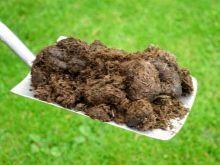
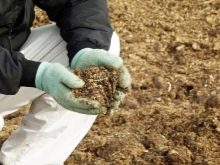
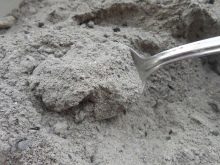
Airing
At first, this process must be treated with great care - small seedlings are extremely sensitive to drafts. Therefore, if you open the vents, only on one side. If the temperature rises to +30, it is imperative to ventilate.
Formation
To grow cucumbers correctly, you need to correctly shape the plant.
How to pinch cucumbers:
- the first 40 cm completely "blind" the shoots;
- the second 40 cm - pinching over the first sheet;
- the next 40 cm - above the second;
- further - above the third, and so on.
Without pinching, the yield decreases, so it is better to treat the bush like this. Cucumbers can be grown at the beginning of growth, half a meter above the ground. There is no need to do above, because a lot of ovaries fall on lateral shoots. The sheet must be carefully bent, and the shoot must be removed with a cloth. The leaves at the bottom of the whip will dry out, the stem will become bare, but very soon roots will begin to grow here, and this will give more nutrition to the bush.
It is also important to tie the cucumbers. In a tied position, they are better illuminated, the lashes are well ventilated (which means there are fewer risks of getting sick), and it is much easier to care for them in protected ground. It is important that the plants do not intertwine with each other when they are tied. Harvesting fruits on tied cucumbers is also easier.
With pollination, everything is both simple and difficult. If the varieties are pollinated, you need to attract bees to the greenhouse. If pollinating by hand, you need to do it with a cotton swab or paint brush.
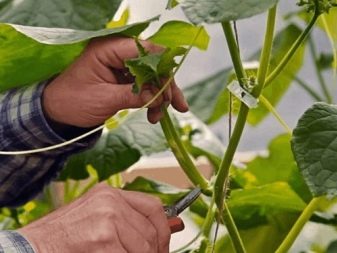
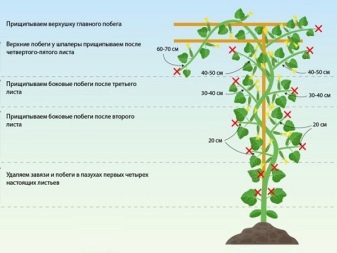
Loosening and hilling
Without this, agricultural technology will not be optimal. It is necessary to loosen and huddle so that the air can get to the roots. Without this, their decay is possible. It has already been said that the roots of a cucumber are not particularly strong, and therefore one of the secrets of their strengthening lies precisely in systematic loosening. There should be no crust on the ground surface.
Diseases and pests
It seems that in a film or glass greenhouse, as well as in a polycarbonate greenhouse, plants get sick less. But it is not so. These are the diseases found in the greenhouse.
- White rot - This is a fungal disease in which the fruits and the entire surface of the bush turn white. The disease progresses very quickly, cucumbers get sick with beds, and the fungus remains in the soil. You will have to get rid of the affected plants, and even change the soil.
- Gray rot - gray spots are formed on the surface of the fruit, slippery and outwardly unpleasant, they can also be on flowers and ovaries. At the initial stages, the disease can be removed with the "Barrier".
- Root rot - leaves dry and fall, cracks appear on the stems. Over-watering and cold water can lead to this disease. Treatment is by sprinkling the affected areas with ash or crushed chalk. With heavily affected plants, nothing can be done, it will not work to fight the disease, you will have to dig out the bushes.
- Powdery mildew - white bloom first appears on the leaves, and then on the stems. The fungus begins to actively spread in warm and damp conditions. You need to treat with "Topaz" and "Barrier".
- Downy mildew - spots on cucumbers resemble burns. Stop watering, ventilate the greenhouse, treat the disease with "Quadris".
- Brown spot - wine-brown spots on the fruits, which even ooze from the inside, after which the whole plant begins to rot. Patients need to be destroyed and taken out of the greenhouse.
- Black mold - resembles a black web, prevention helps more than treatment.
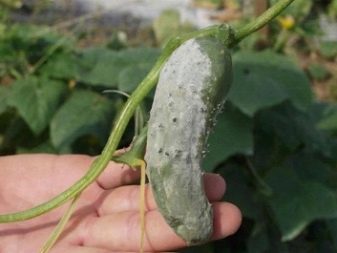
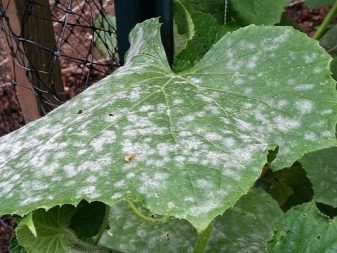
Whatever happens to the plant: leaves or fruits turn yellow, turn white, darken, you need to react very quickly. Not everything is treated, some kind of neglected fusarium jeopardizes the entire crop. And in order to quickly restore cucumbers after a disease that eats away their strength, you can use "Epin", for example. If we talk about relatively universal drugs against diseases of cucumbers, this is, of course, "Fitosporin".
Pest attacks are also possible. For example, melon aphids lead to curled leaves, and shriveled. Aphids eat the plant, feed on its juices. The infusion of onion peels helps well, as well as the ash solution + laundry soap. Another attack - a spider greenhouse mite, is determined by a spider's bloom. You can treat it with Fitoverm and Aktellik. And if ants appear in the greenhouse, and they fatten there, they urgently need to be removed from there.
Processing with any odorous liquid, for example, vinegar, is acceptable - and they need to be watered exactly on the paths along which the ants walk.
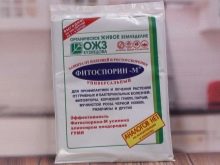
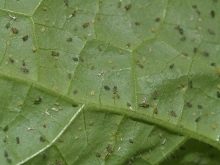

Harvesting
Even the regularity of the harvest affects the harvest, no matter how strange it may sound. If you skip harvesting, letting the fruits lie, others will receive less nutrition - those who are ready to harvest will take too much nutrients for themselves. As soon as the greenback has grown to 10, maximum 15 cm, it must be removed from the garden. And break off only carefully, holding the whip with your hand. Usually you have to walk around the garden every 1-2 days. If sick, crooked, deformed fruits are seen on the plant, they must be removed immediately, because a lot of nutrition is spent on them, and this is unproductive.
Well, what to do with the removed fruits, it's the master's business. The main thing is to eat fresh cucumbers well, as long as there are extremely many vitamins in them (as far as it is, in general, is possible for this culture). The cultivation process begins with the selection of seeds, with their soaking in succinic acid and other measures. And in order to grow a ready-made cucumber, you will have to go a long way step by step, and planting seedlings in a greenhouse is already almost its middle.
And then make sure that the seedlings do not freeze, so that the young shoots do not wither, do not turn yellow. We'll have to stock up on fungicides and fertilizers. But tasty fruits are a reasonable price for such work.
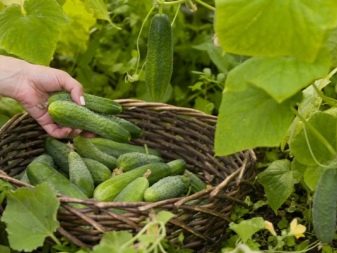
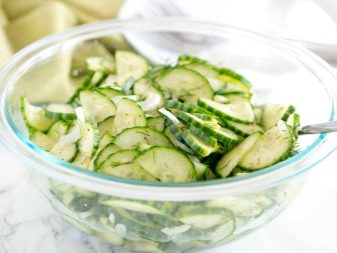













The comment was sent successfully.